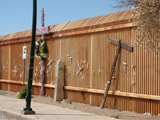Drugs and Vengeance
7 Jul 2009
By Samuel Logan for ISN
Mexico’s Sierra Madre Mountains span across the western half of the country’s north, rising to dramatic heights just miles south of the US border. These peaks and valleys hold a steeped history as one of the world’s most violent and rugged patches of earth. It is a lawless land, where men live by the harsh rules of the gun, where vengeance motivates murder, and the black market has kept families fed for decades.
Those who understand the Sierras, as the locals call these mountains, scoff at the idea that the border violence we’ve heard about for many months now is anything new.
Fleeing from US soldiers in the early 20th century, the last of the Apache Indian rebels hid in the Sierras, daring anyone to find them. The Sierras helped defend Pancho Villa, the legendary Mexican rebel who led an attack on Columbus, New Mexico, which brought the fury of several thousand US soldiers into Mexico. But after 11 months, General John J 'Black Jack' Pershing gave up. He couldn’t find the elusive rebel in the Sierras, even with the support of supply trucks and airplanes.
As history marched forward, two constants remained: Drugs are shipped across the US border; and vengeance is about honor, where murder must always be met with murder.
Drug-trafficking and murder in northern Mexico is a way of life. Violence spikes when the army faces off with different groups of drug traffickers or when these clans seek to kill off one another.
As Richard Grant described in his account of travels in the Sierras, God’s Middle Finger, “The relationship between the army and the drug mafias is dark, bloody, ever-shifting and nightmarishly treacherous.”
All along the border, the level of violence has jumped, with the exception of the military-occupied town of Ciudad Juarez - a single lowly crossing that has been an oasis of peace. Located in the Mexican state of Chihuahua, Ciudad Juarez is home to some 1.5 million people, and combined with its sister city across the border, El Paso, Texas, constitutes one of the world’s largest bi-national metropolitan areas. Here, more than 60,000 people cross the border daily. But despite a growing industrial sector, particularly in the form of product assembly plants, poverty and violence remain widespread. Drug cartels regularly fight for control of transport routes. In 2008 alone, some estimates say that around 6,000 people were killed in this municipality in the scramble.
Los Zetas (also known as the Zetas Organization), a notorious Mexican organized crime group previously thought to be the Gulf Cartel’s death squad but now a network in its own right, has its own agenda and has been behind much of the recent violence. The group is believed to maintain control over territory between the US-Mexico border from El Paso eastward, moving south along Mexico’s eastern coast, through Veracruz and east through Tabasco and into the Yucatan peninsula. Its foot soldiers are believed to number in the thousands and operate a range of illicit businesses from extortion of street vendors to charging tolls for groups passing through their territory, gun and drug-smuggling, human trafficking, kidnapping for ransom and money laundering. Indeed, like Pancho Villa, they have been a new and powerful force in this area.
Poverty remains a serious problem too along the border. Crossing the border by foot from McAllen or Brownsville, Texas, to Matamoros, Mexico, is indeed a compelling journey. Crossing the bridge over the Rio Grande from the US side, Mexican children dangle dangerously above the waters, with one hand clutching the metal fencing, the other shoved through the diamond-shaped hole begging for spare change. Down below, in the murky river, other children tread water, offering to dive for coins tossed down by amused tourists. Some of their parents wait patiently on the banks of the Rio Grande to collect their earnings.
From Douglas to Agua Prieta
external pageDouglas, Arizonacall_made , sits across the border from Agua Prieta, Mexico. Douglas is a small town with a population of less than 15,000, according to the last census, and it is around 86 percent Hispanic.
Situated in Cochise County, the town is part of a landscape of Sierra contours and desert land with sharp rises of rock jutting out of the flat earth, decorated with the regal Saguaro cactus and covered in an endless blanket of desert bush. It is a hot, harsh environment where Border Patrol SUVs far outnumber county police cruisers, and the locals are a weary lot and distrustful of outsiders.
The long, straight road into Douglas parallels the borderline. Every so often, small sheds, just roofs propped up on four poles, dot the landscape - just big enough to shade a border patrol vehicle. The infamous fence on the Douglas side houses spotlights hanging from 20-foot poles, pointed at the Mexican city of Agua Prieta; with a population of over 68,000, it is the seventh-largest community in the Mexican state of Sonora.
In Douglas, a low-security prison sits next to a new shopping center – both destinations for Mexicans, illegal and legal, crossing the border. A new hotel is also under construction, but the older section of Douglas retains its early 20th century charm, leftover from the days when it was a thriving copper-smelting town.
At the last possible turn-off before the road becomes a one-way lane into Mexico sits the BorderMart, a small convenience store heavily trafficked by people making the border trip, and its clientele are indeed interesting: petty gun smugglers, drug and human traffickers, Mexican and local policemen, border patrol guards and everyday people – but aside from those in uniform, it’s hard to tell them apart. And this is where our story begins.

